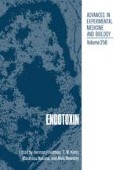Abstract
We examined the binding and functional activities of monoclonal antibodies (mAbs) reactive with different structural elements of Escherichia coli and Salmonella minnesota LPS. 0-side chain-reactive mAbs were highly specific for homologous, smooth LPS, bound avidly to intact bacteria, mediated complement-dependent bactericidal and/or opsonic activity, and protected against live, homologous IP challenges in mice. Core- and lipid A-specific mAbs, on the other hand, were more cross-reactive, although this cross-reactivity was severely restricted by the relative inaccessability of epitopes in the core/lipid A region. This was reflected in the general inability of these mAbs to react with isolated smooth LPS or wild type bacteria, or to mediate bactericidal or opsonic functions. No LPS-reactive mAbs, regardless of molecular specificity, was able to block LPS- or lipid A-induced TNF production by RAW 264.7 macrophages, thus raising doubts concerning the putative endotoxin-neutralizing properties of mAbs reactive with the core/lipid A complex.
Bacterial lipopolysaccharides (LPS) exhibit a complex identity. They represent an essential structural element of the outer membrane of all Gram-negative bacteria (7); they are toxins (5); they mediate a variety of immunomodulatory activities; and they are important bacterial surface antigens (2). In general, LPS macromolecules consist of three genetically, biochemically, and antigenetically distinct regions or domains: the 0-side chain, core oligosaccharide, and lipid A moiety (15). Of these three regions, the 0-side chain is the most phylogenetically diverse. It also represents the most antigenetically exposed element on isolated or cell-associated, native LPS. The core and lipid A structures, in contrast, are relatively conserved among different bacteria and are less accessible to antibody attack by virtue of overlying sugars contained in the 0-side chain or outer core (8).
In this study, we investigated selected functional activities of monoclonal antibodies (mAbs) specific for different epitopes within the three major structural domains of Escherichia coli and Salmonella minnesota LPS. The possible endotoxin-neutralizing and antibacterial properties of these mAbs were our particular focus.
Access this chapter
Tax calculation will be finalised at checkout
Purchases are for personal use only
Preview
Unable to display preview. Download preview PDF.
References
Beutler, B. and Cerami, A., 1987, Cachectin: more than a tumor necrosis factor. N. Eng. J. Med. 716: 379.
Brade, H., Brade, L., Schade, U., Zahringer, U., Holst, O., Kuhn, H.-M., Rozalski, A., Rohrscheidt, E. and Rietschel, E. Th., 1988, Structure, endotoxicity, and antigenicity of bacterial lipopolysaccharides (endotoxins, 0-antigens), in: “Bacterial endotoxins: pathophysiological effects, clinical significance and pharmacological control”, J. Levin, H. R. Buller, S. W. TenCate, S. J. H. VanDeventer, A. Sturk, eds., Alan R. Liss Publishing, New York.
Clas, F. and Loos, M., 1980, Killing of S and Re forms of Salmonella minnesota via the classical pathway of complement activation in guinea pig and human sera. Immunology 40: 547.
Fuller, N. A., Wu, M. C., Wilkinson, R. G. and Heath, E. C., 1973, The biosynthesis of cell wall lipopolysaccharide in Escherichia coli VII. Characterization of heterogenous “core” oligosaccharide structure. J. Biol. Chem. 248: 7938.
Galanos, C., Luderitz, O., Rietschel, E. Th. and Westphal, O., 1977, Newer aspects of the chemistry and biology of bacterial lipopolysaccharides, with special reference to the lipid A component, in: “Biochemistry of lipids,Il”, T. W. Goodwin, ed., University Park Press, Baltimore.
Imoto, M., Yoshimura, H., Kusumoto, S. and Shiba, T., 1984, Total synthesis of lipid A, active principle of bacterial endotoxin. Proc. Jpn. Acad. Ser. B. Phys. Biol. Sci. 60: 285.
Luderitz, 0., Freudenberg, M. A., Galanos, C., Lehmann, V., Rietschel, E. Th. and Shaw, D. H., 1982, Lipopolysaccharides of gram-negative bacteria. Current Topics in Membranes and Transport 17: 79.
Luderitz, O., Staub, A. M. and Westphal, O., 1966, Immunochemistry of 0 and R antigens of Salmonella and related Enterobacteriaceae. Bacterial Rev. 30: 192.
Pollack, M., Chia, J. K. S., Koles, N. L., Miller, M. and Guelde, G., 1988, Monoclonal antibodies that recognize epitopes in the core and lipid A region of lipopolysaccharides, in: “Bacterial endotoxins: pathophysiological effects, clinical significance, and pharmacological control”, J. Levin, H. R. Buller, J. W. TenCate, S. J. H. VanDeventer and A. Sturk, eds., Alan R. Liss Publishing, New York.
Pollack, M., Raubitschek, A. A. and Larrick, J. W., 1987, Human monoclonal antibodies that recognize conserved epitopes in the core-lipid A region of lipopolysaccharides. J. Clin. Invest. 79: 1421.
Rietschel, E. Th., Wollenweber, H. W., Brade, H., Zahringer, U., Linder, B., Seydel, V., Bradaczek, H., Barnickel, G., Labischinski, H. and Giesbrecht, P., 1984, Structure and conformation of the lipid A component of lipopolysaccharides, in: “Handbook of endotoxin. Vol 1: chemistry of endotoxin”, E. Th. Rietschel, ed., Elsevier Science Publishers, Amsterdam.
Ruff, M. and Gifford, G., 1980, Purification and physio-chemical characterization of rabbit tumor necrosis factor. J. Immunol. 125: 1671.
Spiegelberg, H. L., 1974, Biological activities of immunoglobulins of different classes and subclasses. Adv. Immunol. 19: 259.
Teng, N. N. H., Kaplan, H. S., Hebert, J. M., Moore, C., Douglas, H.. Wunderlich, A. and Braude, A. I., 1985, Protection against Gram-negative bacteremia and endotoxemia with human monoclonal IgM antibodies. Proc. Natl. Acad. Sci. U.S.A. 82: 1790.
Wilkinson, S. G., 1977, Composition and structure of bacterial lipopolysaccharides, j: “Surface carbohydrates of the prokaryotic cell”, I. W. Sutherland, ed., Academic Press, New York.
Young, L. S., 1972, Human immunity to Pseudomonas aeruginosa. II. Relationship between heat-stable opsonins and type-specific lipopolysaccharides. J. Infect. Dis. 126: 277.
Author information
Authors and Affiliations
Editor information
Editors and Affiliations
Rights and permissions
Copyright information
© 1990 Springer Science+Business Media New York
About this chapter
Cite this chapter
Pollack, M., Oishi, K., Chia, J., Evans, M., Guelde, G., Koles, N. (1990). Specificity and Function of Monoclonal Antibodies Reactive with Discrete Structural Elements of Bacterial Lipopolysaccharide. In: Friedman, H., Klein, T.W., Nakano, M., Nowotny, A. (eds) Endotoxin. Advances in Experimental Medicine and Biology, vol 256. Springer, Boston, MA. https://doi.org/10.1007/978-1-4757-5140-6_28
Download citation
DOI: https://doi.org/10.1007/978-1-4757-5140-6_28
Publisher Name: Springer, Boston, MA
Print ISBN: 978-1-4757-5142-0
Online ISBN: 978-1-4757-5140-6
eBook Packages: Springer Book Archive

